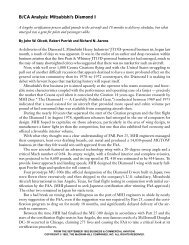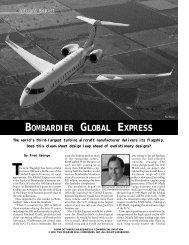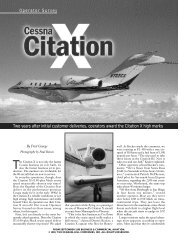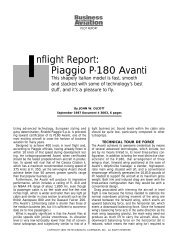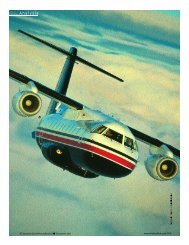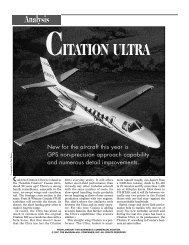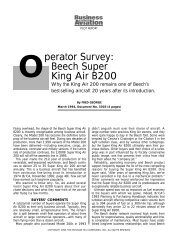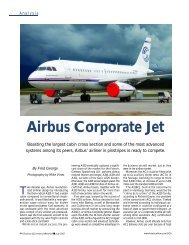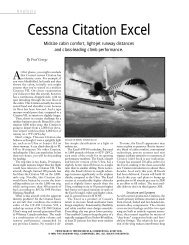nflight Report: Gulfstream G-IV
nflight Report: Gulfstream G-IV
nflight Report: Gulfstream G-IV
You also want an ePaper? Increase the reach of your titles
YUMPU automatically turns print PDFs into web optimized ePapers that Google loves.
PILOT REPORT<br />
I<br />
<strong>nflight</strong> <strong>Report</strong>:<br />
<strong>Gulfstream</strong> G-<strong>IV</strong><br />
A new engine, advanced avionics and the strong<br />
desire to reduce an unexpected drag rise in the G-III<br />
motivated <strong>Gulfstream</strong> to create the impressive G-<strong>IV</strong>.<br />
By JOHN W. OLCOTT<br />
January 1987 Document # 2904, 5 pages<br />
Aircraft designers quest for perfection, yet live with<br />
compromise and occasional surprises. The products of<br />
their labors exemplify the fact that the best efforts of talented<br />
men and women do not always produce exactly<br />
what was predicted, in spite of the marvels of our computer<br />
age.<br />
Such was the lesson reconfirmed when the <strong>Gulfstream</strong><br />
III took to the skies seven years ago. Although the G-III<br />
is an impressive and capable performer, it experiences<br />
more aerodynamic drag than its designers predicted-so<br />
much additional drag, in fact, that the aircraft was in<br />
jeopardy of falling short of its guaranteed range performance.<br />
Wind tunnel studies and analytical calculations<br />
failed to predict the aircraft’s drag rise at higher Mach<br />
numbers, thereby causing <strong>Gulfstream</strong>’s performance<br />
engineers to overestimate specific range.<br />
Had it not been for another, more fortunate example<br />
of the innate imperfection of design, the G-III would<br />
have missed its range goal by more than the five percent<br />
leeway allowed. But because the aircraft’s wing<br />
was capable of carrying more fuel than was predicted,<br />
thus compensating for the unexpected drag, the aircraft<br />
just did meet its range guarantees.<br />
Designers, however, are unwilling to rely on serendipity,<br />
no matter how much they appreciate being the<br />
recipient of its largess. Thus when the <strong>Gulfstream</strong> <strong>IV</strong><br />
was conceived, a closer look at high-speed drag was<br />
uppermost on the list of design priorities.<br />
Had it not been for the unexpected drag of the G-III,<br />
the G-<strong>IV</strong> might well have been less grand than it has<br />
now emerged. Originally, <strong>Gulfstream</strong>’s plan was to reengine<br />
the G-III with Rolls-Royce Tay turbofans and<br />
stretch the aircraft’s nose a modest and somewhat uninspiring<br />
two feet. But with wind tunnel and flight test<br />
results clearly demonstrating that something could be<br />
done to improve performance, <strong>Gulfstream</strong> accepted the<br />
challenge to make a better wing for the new aircraft.<br />
NEW TESTS<br />
Based upon flight tests of the G-III as well as correlations<br />
between wind tunnel and flight data on both the<br />
G-II and G-III, <strong>Gulfstream</strong> engineers suspected that the<br />
original wind tunnel studies of the G-III were inaccurate<br />
at high Mach numbers, possibly because insufficient<br />
allowances were made for the characteristics of the particular<br />
tunnel that <strong>Gulfstream</strong> hired.<br />
Rather than debate the vendor who conducted those<br />
tests, however, <strong>Gulfstream</strong> contracted with a facility in<br />
Bedford, England to evaluate the G-III and develop the<br />
basis for creating a more efficient G-<strong>IV</strong>. Over 800<br />
hours of tunnel tests were conducted, focusing largely<br />
on how best to mount the larger Tay engines on the<br />
slender <strong>Gulfstream</strong> fuselage.<br />
The tunnel tests revealed a need to move the Tay<br />
engines back 18 inches and up 10 degrees on the fuselage.<br />
This new location was required to place the<br />
engines farther away from the wing, thereby reducing<br />
the drag that occurs when air at high speed becomes<br />
COPYRIGHT 1995 THE MCGRAW-HILL COMPANIES, INC. ALL RIGHTS RESERVED
P ilot<br />
<strong>Report</strong><br />
blocked as it attempts to flow through the three-sided<br />
channel formed by the wing, fuselage and engine<br />
nacelle.<br />
In addition to encountering an occasional surprise,<br />
another reality of aircraft design is the interdependence<br />
of each element in the vehicle. Rarely can one change<br />
in a fundamental area- such as engine placement-be<br />
accomplished without its effect being felt somewhere<br />
else in the design. In this case, moving the Tay engines<br />
farther aft created a balance problem that necessitated<br />
another one-foot stretch in the fuselage forward of the<br />
wing. That added pounds to the G-<strong>IV</strong>, which caused the<br />
engineers to look for ways to reduce weight through<br />
redesign.<br />
The wing seemed to be a logical place to start. By<br />
moving from a wing structure predicated on fail-safe criteria<br />
to one based upon the more modern concept of<br />
damage tolerance, weight could be reduced. A new<br />
wing structure also would allow the engineers a relatively<br />
free hand with airfoil re-contouring to tackle the<br />
drag creep at high Mach numbers that beset the G-III.<br />
Using the inputs from the tunnel tests conducted in<br />
Bedford and applying new computer programs aimed<br />
at improved predictions of lift and drag, particularly at<br />
higher speeds, <strong>Gulfstream</strong> engineers determined that<br />
the outboard portions of the G-<strong>IV</strong> wing required a new<br />
shape. In spite of their new location further aft on the<br />
fuselage, the Tay engines (which are noticeably wider<br />
in diameter than the G-II and G-III’s Spey powerplants)<br />
were still interfering with the air flow near the inboard<br />
portions of the wing, thereby causing the outer portions<br />
of the wing to produce an excessive portion of the total<br />
lift needed to support the aircraft’s weight. Thus the<br />
span-wise distribution of lift was not efficiently spread<br />
along the length of the wing, and drag continued to be<br />
higher than desired.<br />
To solve this problem, <strong>Gulfstream</strong> engineers extended<br />
the leading edge of the outer two-thirds of the wing by<br />
about 7.5 inches and twisted the wing so that the outer<br />
portion is drooped by about a degree. They also<br />
changed the leading-edge contour to achieve the characteristics<br />
of a supercritical airfoil along the modified<br />
portion of the wing. In addition to distributing a greater<br />
portion of the lift inboard, thereby allowing the wing to<br />
produce lift more efficiently by lessening induced drag,<br />
the new shape reduced the effective sweep angle of the<br />
wing outboard, which reduced the drag resulting from<br />
shock waves that form at high subsonic Mach numbers.<br />
The net result was five percent less drag at high<br />
speed and the ability to achieve a normal cruise at<br />
0.80 Mach. The new wing design is so good, in fact,<br />
that the G-<strong>IV</strong> can cruise at 0.85 Mach and has an<br />
MMO of 0.88.<br />
Not all the wing changes were aerodynamic, however.<br />
The G-<strong>IV</strong> wing is structurally quite different than its<br />
predecessor. The three upper wing panels employed on<br />
the G-III have been replaced with a single upper skin,<br />
and all access panels have been located on the lower<br />
wing surface. The new wing has 23 fewer ribs and 70<br />
percent fewer internal fasteners. In total, 30-percent<br />
fewer parts are needed to construct the G-<strong>IV</strong> wing, compared<br />
with its predecessor. Furthermore, the new airfoil<br />
weighs 870 pounds less than the G-III wing, has 30-<br />
percent fewer structural parts, costs less to build and<br />
can accommodate 1,000 pounds more fuel.<br />
NEW AIRCRAFT THROUGHOUT<br />
The wing is not the only item that has been redesigned.<br />
While the G-<strong>IV</strong>’s fuselage is essentially that of a G-III<br />
with a three-foot plug just aft of the cabin entrance, its<br />
aft pressure bulkhead has been redesigned and constructed<br />
of high-strength, carbon composite material that<br />
enables the surface to be flat, not conical like the G-III’s.<br />
Consequently, compared with the G-III, the G-<strong>IV</strong>’s pressurized<br />
interior contains 4.5 feet more usable space-3.0<br />
feet from the stretch and 1.5 feet from the redesigned<br />
pressure bulkhead.<br />
Lighter weight, high-strength steel is used in the landing<br />
gear, and Permaswage fittings have replaced the<br />
conventional joints used in the hydraulic system in order<br />
to save weight and reduce the likelihood of leaks.<br />
Unlike the G-III’s hydraulics, the G-<strong>IV</strong> system operates at<br />
a constant pressure of 3,000 psi, rather than switching<br />
between 3,000 and 1,500 psi.<br />
The G-<strong>IV</strong> also employs a “brake-by-wire” system built<br />
by Goodyear, and a “steer-by-wire” system built by<br />
Dowty. Instead of the pilot’s brake pedals and nosewheel<br />
steering handle being directly linked to the<br />
appropriate hydraulic valve, each is connected to its<br />
own transducer, which sends an electrical signal to the<br />
brake valves or nosewheel steering unit, which receive<br />
their muscle from hydraulic pressure. These signals are<br />
processed to achieve the desired response, thereby providing<br />
the pilot with excellent control over braking and<br />
steering.<br />
The most obvious and outwardly impressive changes<br />
that distinguish the G-<strong>IV</strong> from the G-III (and their competitors)<br />
are the Rolls-Royce Tay engines and the Sperry<br />
electronic flight instrument system.<br />
Designed around the core of the Spey RB.183-555<br />
engine (which powers the Fokker F28) rather than the<br />
RB.183-511-8 used in the G-III, the Tay incorporates<br />
fan technology that was developed in conjunction with<br />
the RB.211 series of turbofans that powers a number of<br />
wide-body airliners.<br />
Because the Spey has accumulated well over 30 million<br />
flight hours in its illustrious career, the Tay starts life<br />
with a 7,000-hour time between overhaul and a 3,500-<br />
COPYRIGHT 1995 THE MCGRAW-HILL COMPANIES, INC. ALL RIGHTS RESERVED
hour hot-section inspection interval.<br />
Operators of the G-<strong>IV</strong>, therefore, will<br />
enjoy the same overhaul periods that<br />
operators of the G-II and G-III do.<br />
The Tay, however, is neither as<br />
thirsty nor as noisy as the Spey. Flatrated<br />
at 12,420 pounds of thrust<br />
(which it can maintain up to 35<br />
degrees C) and capable of delivering<br />
a specific fuel consumption at 0.80<br />
Mach that is 16 percent less than that<br />
of the Spey installed in the G-III, the<br />
Tay provides the G-<strong>IV</strong> with lots of<br />
brawn and a more reasonable<br />
appetite for calories. Since the G-<strong>IV</strong><br />
has a maximum takeoff weight of<br />
71,700 pounds (2,000 pounds more<br />
than the G-III’s), its power loading is<br />
about the same as its predecessor’s in<br />
spite of the greater thrust of the Tay.<br />
Hot-and-high performance is better<br />
due to the Tay’s ability to produce<br />
rated power in temperatures considerably<br />
above ISA.<br />
Unlike the Spey, which produces a<br />
fair share of noise as it converts Jet A<br />
into thrust, the Tay is impressively<br />
quiet. Sideline noise during a takeoff<br />
at maximum gross weight is 88.8<br />
EPNdB, takeoff noise at the same<br />
weight is only 79.1 EPNdB, and<br />
approach noise at the G-<strong>IV</strong>’s maximum<br />
landing weight of 58,500<br />
pounds is 91.0 EPNdB. Those figures<br />
are well below FAR Part 36, Stage 3<br />
requirements, which are 94, 89 and<br />
98 EPNdB, respectively. In terms of<br />
sound measured on the A scale (dBA<br />
is the yardstick many municipalities<br />
use to set their noise curfews), the G-<br />
<strong>IV</strong> enjoys a takeoff reading of 67 dBA<br />
COPYRIGHT 1995 THE MCGRAW-HILL COMPANIES, INC. ALL RIGHTS RESERVED
P ilot<br />
<strong>Report</strong><br />
and an approach reading of 83 dBA. These figures,<br />
incidentally, are below Washington National Airport’s<br />
nighttime limits, which are 72 dBA for takeoff and 85<br />
dBA for approach.<br />
During B/CA’s visit to Savannah, home of <strong>Gulfstream</strong><br />
Aerospace, we listened as the G-<strong>IV</strong> made several takeoffs,<br />
flybys and approaches. We were impressed. With<br />
our editorial offices located at Westchester County Airport,<br />
home of more G-IIs and G-IIIs than any other airport<br />
in the United States, we are very familiar with the<br />
sound of the Spey engine. The Tay is noticeably quieter.<br />
Another important although lesser-known requirement<br />
for engines deals with air pollution. At idle<br />
power, where emissions are measured, the Tay is sufficiently<br />
efficient to be well within the limits set by<br />
SFAR Part 27. The powerplant also satisfies the standards<br />
set for smoke.<br />
Both the improved efficiency and the lower sound levels<br />
associated with the Tay are due in part to the<br />
engine’s fan technology, such as the use of wide-chord<br />
blades made of titanium, and its three-to-one bypass<br />
ratio. The improved emissions are the result of more<br />
complete combustion and higher thermal efficiency,<br />
also due to the use of higher levels of technology than<br />
that employed in the Spey.<br />
ALMOST STAR WARS<br />
As if the G-<strong>IV</strong>’s new wing, improved structure,<br />
stretched fuselage and new engines weren’t enough<br />
to capture the hearts of chief pilots as well as chief<br />
executives, the aircraft’s flight deck is something that<br />
cannot be resisted. Consisting of six eight-inch by<br />
eight-inch, full-color cathode ray tubes (CRTs), the EFIS<br />
designed and manufactured by Sperry Flight Systems<br />
is nothing short of fantastic.<br />
Sperry has introduced an advanced symbology<br />
specifically for the G-<strong>IV</strong>, and some familiarization is<br />
required before a pilot can appreciate fully its presentation.<br />
But adopting to the wealth of information that<br />
Sperry provides comes quickly, and the small effort<br />
required to grasp the value of these presentations is<br />
worthwhile.<br />
Although each of the six CRTs that are spread across<br />
the instrument panel is identical, the outermost two are<br />
the primary flight displays (one for the pilot; the other<br />
for the copilot). Moving inboard, the next two are the<br />
pilot’s and copilot’s navigational displays, and the<br />
remaining two constitute the engine instrument and<br />
crew alerting system (EICAS). These central CRTs are<br />
mounted one on top of the other; the top tube is used to<br />
present engine data, and the bottom tube provides<br />
warning messages and information related to the aircraft’s<br />
systems.<br />
Flight management also is provided by Sperry, via<br />
Specifications <strong>Gulfstream</strong> G-<strong>IV</strong><br />
(Preliminary)<br />
B/CA EQUIPPED PRICE $15,800,000 (1986 dollars)<br />
SEATS 2+14/19<br />
ENGINE<br />
Model 2 RR Tay Mk 610-8<br />
Power<br />
12,420 lbs ea.<br />
TBO 7,000<br />
DESIGN WEIGHTS (lb/kg)<br />
Max ramp 70,200/31,843<br />
Max takeoff 69,700/31,616<br />
Max landing 58,500/26,536<br />
Zero-fuel 44,000/19,958<br />
BOW (B/CA equipped) 39,100/17,736<br />
Max payload 4,900/2,223<br />
Useful load 31,100/14,107<br />
Max usable fuel 29,300/13,290<br />
Payload (max fuel) 1,800/816<br />
Fuel (max payload) 26,200/11,884<br />
LOADING<br />
Wing (lb/ft 2 ) 73.3<br />
Power (lb/hp) 2.8<br />
PSI 9.5<br />
LIMIT SPEEDS (KCAS)<br />
MMO 0.850<br />
VMO 340<br />
VFE (app) 220<br />
V2 144<br />
VREF 116<br />
PERFORMANCE (SL, ISA, MGTOW)<br />
BFL (ft/m) 5,100/1,554<br />
BFL, 5,000 ft. ISA 20 0 C (ft/m) 7,150/2,179<br />
Climb (fpm/mpm)<br />
All-engine 4,070/1,241<br />
Engine-out 1,080/329<br />
Certificated ceiling (ft/m) 45,000/13,716<br />
All-engine<br />
service ceiling (ft/m) 43,800/13,350<br />
Engine-out<br />
service ceiling (ft/m) 30,730/9 367<br />
Part 121 landing<br />
distance (ft/m) 2,670/814<br />
NBAA VFR range (ft/m) 4,746/1,447<br />
NBAA IFR range (ft/m) 4,371/1,332<br />
dual FMZ-800 FMSes that can accomplish both lateral<br />
and horizontal navigation as well as performance computations<br />
with impressive clarity. Both plan and elevation<br />
views of the aircraft’s progress will be presented on the<br />
aircraft’s navigational displays (the CRTs just inboard of<br />
the primary flight displays) once all the software is certificated,<br />
and an autothrottle is to be installed within the<br />
next year, thereby completing the elements needed for<br />
complete performance management.<br />
The FMSes receive data from dual Honeywell laser<br />
inertial-reference systems as well as from Collins navigational<br />
receivers. (Collins also provides the communications<br />
radios.) Provisions have been made to accept<br />
COPYRIGHT 1995 THE MCGRAW-HILL COMPANIES, INC. ALL RIGHTS RESERVED
P ilot<br />
<strong>Report</strong><br />
inputs from all conceivable sensors, such as global positioning<br />
satellites, VLF/Omega stations and microwave<br />
landing systems.<br />
Pilot input to the EFIS, EICAS and much of the FMS is<br />
by means of a display controller mounted just below the<br />
glareshield, directly in front of the pilots. Each airman<br />
has within easy reach and in his direct line of sight a<br />
small, rectangular CRT that depicts the selected modes<br />
of EFIS operation and presentation. A wealth of information<br />
can be presented there, including performance<br />
speeds such as V1, VR, V2, etc.<br />
FLYING THE G-<strong>IV</strong><br />
Upon entering the cockpit of the G-<strong>IV</strong>, a pilot’s first<br />
impression may well be that something is missing. The<br />
instrument panel is bleak and lifeless...until the electrical<br />
power is turned on. Then the panel erupts in color and<br />
impressive arrays of meaningful presentations as the six<br />
CRTs become active.<br />
Programming the FMS for flight and entering performance<br />
airspeeds into the EFIS is accomplished easily.<br />
While the Honeywell LASEREF II was aligning, which<br />
took six minutes, we programmed into the display controller<br />
the aircraft’s V-speeds for our demonstration<br />
weight of 57,940 pounds. Consequently, these performance<br />
speeds were annunciated on the vertical tape<br />
that depicts airspeed on the left-hand edge of the primary<br />
flight display.<br />
The starting process for the Tays is easy as the Sperry<br />
EICAS tracks turbine gas temperature (TGT) and other<br />
engine parameters. Had a start value been exceeded,<br />
the EICAS needle for the appropriate indicator would<br />
have turned red to provide a vivid warning of the undesired<br />
condition.<br />
In spite of its size, the G-<strong>IV</strong> taxies with the grace of a<br />
typical business jet. The Tays respond nicely to small<br />
power requests, and their idle speed is sufficiently low<br />
so that there was no need to rely heavily on the aircraft’s<br />
carbon brakes to assure a comfortable taxiing<br />
speed. Dowty’s steer-by-wire system provides excellent<br />
harmony between inputs by either the nosewheel-steering<br />
wheel to the pilot’s left (for sharp turns) or by the<br />
rudder pedals (for up to seven degrees of nosewheel<br />
deflection). The brake-by-wire system also functions<br />
smoothly and effectively.<br />
Acceleration to our V, speed of 104 KIAS, through<br />
VR of 124 and on to a V2 of 138 KIAS, was quickunder<br />
20 seconds. The aircraft tracked very well in<br />
spite of a slight crosswind from the left. The stick forces<br />
required for rotation were comfortable, and the aircraft’s<br />
initial rate of climb was impressive, as one might<br />
expect at our considerably reduced takeoff weight.<br />
Despite some ATC delays, the climb to our initial<br />
cruise altitude was 22 minutes and 40 seconds from<br />
brake release. The unrestricted climb between FL 220<br />
and FL 450, which is the aircraft’s intended ceiling,<br />
required only 12 minutes and 54 seconds. At altitude,<br />
where the temperature was -64 degrees C, we easily<br />
achieved a cruise Mach number of 0.80 on a total fuel<br />
flow of 2,560 pph, which yielded a specific range of<br />
0.176. Increasing the fuel flow to 3,250 pph, we<br />
obtained a cruise of 0.85 Mach with an aircraft weight<br />
of 54,845 pounds. Specific range for that condition<br />
was 0.147. (<strong>Gulfstream</strong> says that production Tays will<br />
produce six percent more thrust above FL 400 than the<br />
engines on the aircraft that we were flying.)<br />
The G-<strong>IV</strong>’s handling qualities during the climb and at<br />
cruise were typically <strong>Gulfstream</strong>. In fact, a design goal<br />
was to make the G-<strong>IV</strong> fly like the G-III, and that objective<br />
has been achieved. The aircraft exhibits good pitch<br />
response in both its short- and long-period modes; its<br />
lateral/directional characteristics are good, with low<br />
adverse yaw and a damped Dutch roll. Stall protection<br />
is provided by a stick shaker and stick pusher, as in the<br />
G-III, even though the G-<strong>IV</strong>’s new wing provides about<br />
one degree more stall margin than does the G-III’s.<br />
High-speed buffet, when excited by a steep turn at altitude,<br />
produced an easily manageable shutter that is<br />
most apparent in the ailerons.<br />
In the approach configuration, the G-<strong>IV</strong> exhibits very<br />
good speed stability and tracks heading nicely. Small<br />
changes in heading, such as those a pilot would make<br />
if hand-flying an ILS approach, can be made with ease.<br />
The control forces needed to flare the G-<strong>IV</strong> are comfortably<br />
low, and ground handling is good right from the<br />
moment of touchdown .<br />
(Incidentally, the EFIS presentation seems to reduce<br />
the workload normally associated with precision tracking<br />
of airspeed and heading, although some time is<br />
needed to adopt to the somewhat unfamiliar orientation<br />
of airspeed, attitude and altitude on the primary flight<br />
display.)<br />
Truly, the <strong>Gulfstream</strong> is an example of the quest for<br />
perfection in a business aircraft. It has impressive performance,<br />
futuristic-and very effective-flight instrumentation,<br />
modern systems and good handling qualities.<br />
Corporate pilots and corporate executives will find considerable<br />
pleasure in the G-<strong>IV</strong> well into the 21st century.<br />
B/CA<br />
COPYRIGHT 1995 THE MCGRAW-HILL COMPANIES, INC. ALL RIGHTS RESERVED



